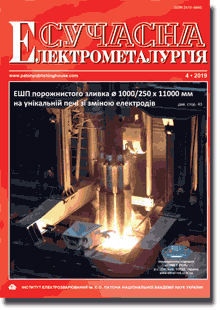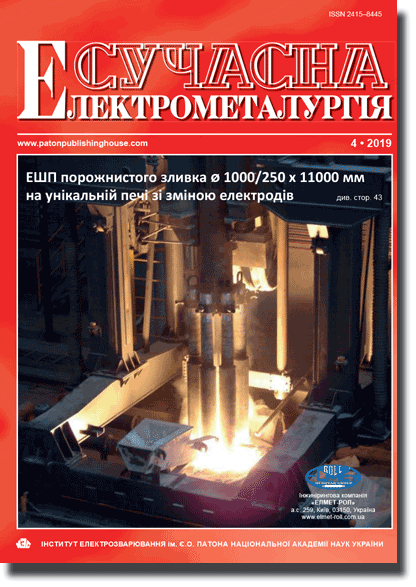| 2019 №04 (03) |
DOI of Article 10.15407/sem2019.04.04 |
2019 №04 (05) |

"Suchasna Elektrometallurgiya" (Electrometallurgy Today), 2019, #4, 26-31 pages
Journal SEM
Publisher International Association «Welding»
ISSN 2415-8445 (print)
Issue № 4, 2019 (November)
Pages 26-31
Forming consumable electrodes from briquetted sponge titanium in electron beam unit
S.V. Akhonin1, A.N. Pikulin1, V.O. Berezos1, A.Yu. Severin1, O.G. Erokhin2
1E.O. Paton Electric Welding Institute of the NAS of Ukraine. 11 Kazymyr Malevych Str., 03150, Kyiv, Ukraine. E-mail: office@paton.kiev.ua
2SC «SPC «Titan» of the E.O. Paton Electric Welding Institute of the NAS of Ukraine». 26 Raketna Str., 03028, Kyiv, Ukraine. Е-mail: titan_paton@gmail.com
A set of research works on electron beam melting of the surface layer of consumable electrodes from briquetted sponge titanium of TG110 grade was performed in a specialized electron beam unit. Electron beam melting of both its entire surface layer and of just the longitudinal sections was conducted, in order to assess the increase of consumable electrode strength properties. The results of the performed work showed that the surface layer is melted-through completely to the depth of up to 13 mm for electrodes with the surface partially treated by a focused electron beam and up to 9 mm for electrodes with the surface completely treated by scanning electron beam, and the melted layer metal is characterized by a cast structure with absence of cavities or discontinuities, with gas impurity content on the level of standard requirements. Experimental data were used to calculate the safety factors of consumable electrodes from compacted briquettes of sponge titanium, treated by the electron beam. It is shown that partially treated by focused electron beam surface of the consumable electrode formed from briquetted sponge titanium with minimum penetration depth of 6 mm, ensures sufficient strength properties of the electrode that will allow preventing its failure during melting in the furnace working space. The completely melted by a scanning electron beam surface layer of a consumable electrode formed from briquetted sponge titanium of minimum thickness of 4 mm, will provide sufficient characteristics of electrode strength and will prevent saturation of inner layers of sponge titanium electrode with moisture, when exposed to open air. Ref. 10, Tabl. 1, Fig. 8.
Key words: electron beam surface melting; consumable electrode; electron beam gun; surface layer; penetration depth; safety factor
Received: 28.11.19
Published: 23.09.19
References
1. Paton, B.E., Trigub, N.P., Akhonin, S.V., Zhuk, G.V. (2006) Electron beam melting of titanium. Kiev, Naukova Dumka [in Russian].2. Belov, V.D., Fadeev, A.V., Ivashchenko, A.I., Beltyukova, S.O. (2013) Technology of vacuum melting and casting. Vacuum melting and manufacture of shaped castings of titanium and titanium alloys. Moscow, MISiS [in Russian].
3. Ivchenko, Z.A., Lunev, V.V. (2010) Manufacture and application of extruded titanium briquettes. Novi Materialy i Tekhnologii v Metalurgii ta Mashynobudivnytstvi, 1, 90–92 [in Ukrainian].
4. Medovar, L.B., Saenko, V.Ya., Ryabinin, V.A. (2009) Manufacture of consumable electrodes from spongy titanium for producing ingots using ESR and ASR methods. Sovrem. Elektrometall., 3, 23–25 [in Russian].
5. Altman, P.S., Goncharov, A.E. (2008) Method of manufacture of consumable electrode. Pat. 2331679 RF [in Russian].
6. Nochovnaya, N.A., Alekseev, E.B., Yasinsky, K.K., Kochetkov, A.S. (2011) Specifics of melting and methods of producing of intermetallic titanium alloy ingots with higher niobium content. Vestnik N.E. Baumana MGTU, Ser. Mashinostroenie, SP2, 53–59 [in Russian].
7. Modelkin, Yu.I., Torkhov, G.F., Latash, Yu.V., Tager, L.R. (1981) Examination of plasma-arc remelting of surface layer of electrodes for VAR from heat-resistant alloy EI698. Spets. Elektrometall., 47, 106–111[in Russian].
8. Latash, Yu.V., Matyakh, V.N., Voronin, A.E. (1981) Examination of electroslag cleaning process of surface of metallic billets. Ibid., 46, 11–18 [in Russian].
9. Trigub, N.P., Zhuk, G.V., Pikulin, A.N. et al. (2003) Electron beam installation UE-185 for fusion of surface layer of ingots. Advances in Electrometallurgy, 3, 10–12.
10. Illarionov, A.G., Popov, A.A. (2014) Technological and service properties of titanium alloys: Manual. Ekaterinburg, Ural. Un-t [in Russian].
The cost of subscription/purchase order journals or individual articles
| Journal/Currency | Annual Set | 1 issue printed |
1 issue |
one article |
| TPWJ/USD | 384 $ | 32 $ | 26 $ | 13 $ |
| TPWJ/EUR | 348 € | 29 € | 24 € | 12 € |
| TPWJ/UAH | 7200 UAH | 600 UAH | 600 UAH | 280 UAH |
| AS/UAH | 1800 UAH | 300 UAH | 300 UAH | 150 UAH |
| AS/USD | 192 $ | 32 $ | 26 $ | 13 $ |
| AS/EUR | 180 € | 30 € | 25 € | 12 € |
| SEM/UAH | 1200 UAH | 300 UAH | 300 UAH | 150 UAH |
| SEM/USD | 128 $ | 32 $ | 26 $ | 13 $ |
| SEM/EUR | 120 € | 30 € | 25 € | 12 € |
| TDNK/UAH | 1200 UAH | 300 UAH | 300 UAH | 150 UAH |
| TDNK/USD | 128 $ | 32 $ | 26 $ | 13 $ |
| TDNK/EUR | 120 € | 30 € | 25 € | 15 € |
AS = «Automatic Welding» - 6 issues per year;
TPWJ = «PATON WELDING JOURNAL» - 12 issues per year;
SEM = «Electrometallurgy Today» - 4 issues per year;
TDNK = «Technical Diagnostics and Non-Destructive Testing» - 4 issues per year.





